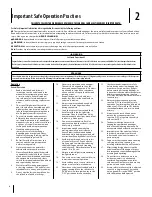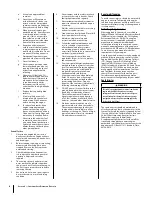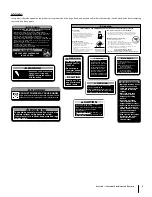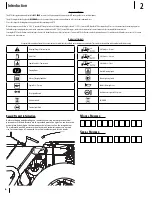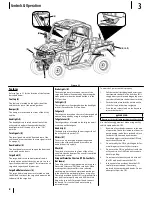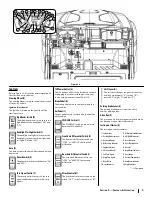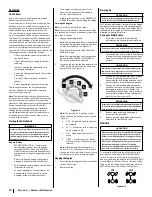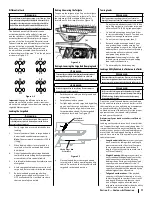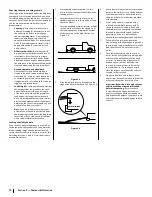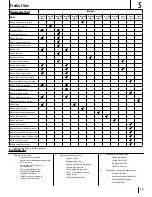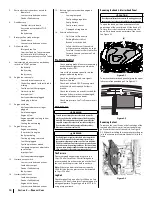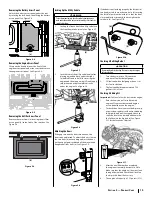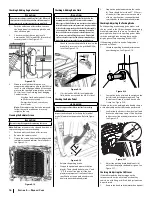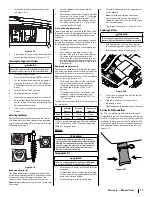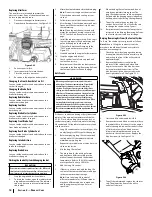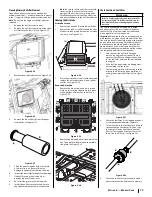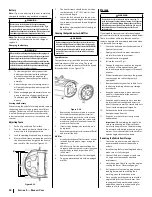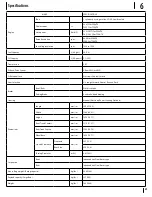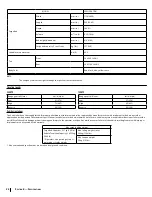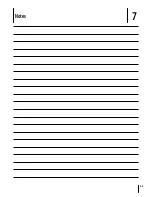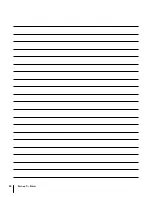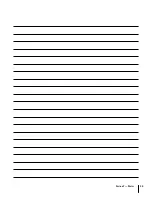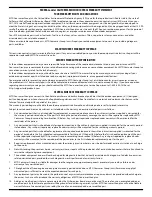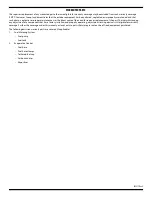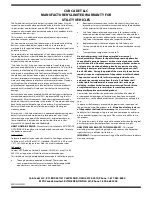
14
S
ection
5 — P
roduct
c
are
5.
Entire electrical system does not work:
•
Blown fuse
•
Loose or corroded connections
•
Dead or Faulty battery
6.
Dead battery:
•
Shorted starter solenoid
•
Key switch not turned to STOP
position
•
Faulty battery
7.
Battery will not take a charge:
•
Dead battery
•
Loose or corroded connections
8.
Difficult to shift:
•
Idle speed too fast
•
Gears not lined up. Tap throttle and
let it return to idle. If still hard to
shift, contact your nearest Cub Cadet
dealer
9.
Indicator lights do not come on when key
switch is in START position:
•
Faulty bulb
•
Faulty wiring
•
Faulty sensor
10.
Engine runs unevenly:
•
Loose electrical connections
•
Choke (if equipped) or throttle cable
sticking
•
Fuel line or fuel filter plugged
•
Stale or dirty fuel
•
Improper fuel
•
Air cleaner element plugged
•
Spark plug is fouled
11.
Engine overheats:
•
Air cleaner element missing or
plugged
•
Air intake plugged.
•
Engine oil low
•
Engine operated too long at slow
engine speed
•
Cooling fan not turning
12.
Engine loses power:
•
Engine overheating
•
Too much oil in engine
•
Faulty spark plug
•
Fuel supply being restricted
•
Fuel filter plugged
•
Fuel line pinched or kinked
•
Fuel pump output not adjusted to
specification
•
Improper fuel
•
Air cleaner element plugged
13.
Starter does not work:
•
Loose or corroded connections
•
Low battery output
•
Dead or Faulty battery
•
Faulty starter
14.
Starter cranks slowly:
•
Low battery output
•
Dead or Faulty battery
•
Engine oil too heavy
•
Loose or corroded connections
Removing the Hood & Interior Hood Panel
CAUTION
To avoid personal injury from contact with moving parts never
open operator’s seat or hood cover while the engine is running.
To open the hood, pull up on the center of the
upper edge of the cover (a) and lift the hood off.
To close, insert the front bottom hooks into the
hood. Push down on the perimeter of the cover.
See Figure 5-1.
(a)
Figure 5-1
To remove the interior hood panel (a), grasp the upper
left corner of the panel and pull. See Figure 5-2.
(a)
Figure 5-2
Removing the Seat
To remove the seat, lift up on the front edge of the
seat and after the two pins (a) clear the bushings
pull towards the front of the vehicle. See Figure
5-3. When re-installing the seat, make sure the pins
(a) in the seat are inserted into the holes (b) in the
frame.
(a)
(a)
(b)
(b)
Figure 5-3
15.
Battery light comes on when engine is
running:
•
Low engine speed
•
Faulty voltage regulator
•
Faulty battery
•
Faulty rotor or stator
•
Damaged wiring harness
16.
Vehicle will not move:
•
Shift Lever still in neutral
•
Parking Brake is still set
•
Broken or cut drive belt
•
Safely check to see if the vehicle
will go in reverse and then try to go
Forward. If vehicle still will not move
forward, contact your nearest Cub
Cadet dealer.
Pre-Start Checklist
•
Check parking brake. Make sure the parking
brake indicator light comes on when the
parking brake is ON.
•
Inspect the Instrument panel for broken
gauges and warning lamps.
•
Check the headlights and turn signals.
Replace if broken.
•
Check seat belt and OPS. Do not operate
utility vehicle until repaired if either is
broken.
•
Check the joint boots on the drive shaft for
damage. If they joint boots are damaged,
see an authorized service dealer.
•
Check tire pressure. See Tire Pressure in this
section.
Maintenance
WARNING
To avoid personal injury, be sure to check and service the
vehicle on a flat surface with the engine off and the parking
brake ON. If servicing under the cargo bed, be sure that the
cargo bed is supported so that it can not inadvertently close.
Do not touch muffler or exhaust pipes while they are hot;
Otherwise, severe burns could result.
WARNING
If vehicle diagnosis requires the vehicle to be run with the
wheels off the ground the free wheeling state will cause
the engine management system to create a lean condition.
This lean condition will cause the exhaust system to become
hotter than normal operating conditions. Exercise extreme
caution when working around the exhaust components and
allow extra time for the exhaust components to cool.
Tire Pressure
The recommended operating tire pressure is
14 psi (70 kPa) for all tires. Overinflating above
recommended tire pressure can reduce the life of
the tire. Check tire pressures before each use.
Note:
If the cargo bed is at maximum capacity
(1000 lbs), the rear tire pressure can be increased
to 18 psi (124 kPa).
Lug Nuts
Check torque of lug nuts after first 50 hours of use
and every 100 hours thereafter. Tighten lug nuts in
a diagonal pattern. Torque lug nuts to 65-75 lb-ft
using a torque wrench.
Содержание 550 2017
Страница 23: ...Notes 7 23...
Страница 24: ...24 Section 7 Notes...
Страница 25: ...25 Section 7 Notes...


